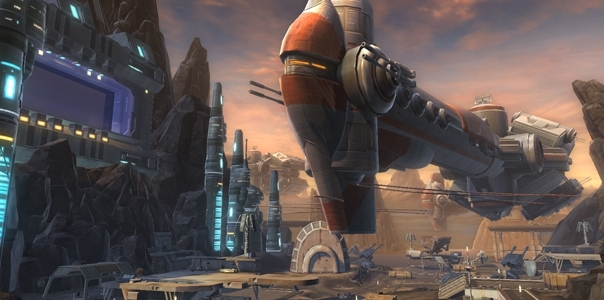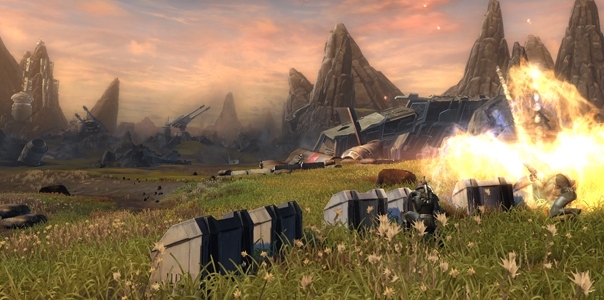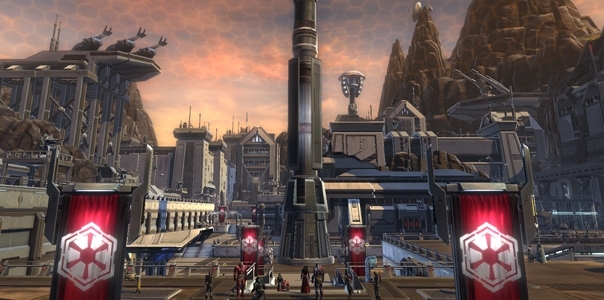SWTOR: Unfair-to-Play?
Are free-to-play gamers welcome in BioWare's flagship MMO? Gareth "Gazimoff" Harmer shares his opinion on SWTOR's recent transition.

Editorial: When I first heard about Star Wars: The Old Republic moving to Free-to-Play, I cheered BioWare on for making a smart move. As it became increasingly squashed under the weight of a number of summer releases, the switch to free would breathe new life into the game just as Christmas approached. At least, that was the theory.
What actually happened was an onslaught of concern and criticism over what would generously be described as “overly aggressive monetization”. When patch 1.5 went live on the public test server, and we were able to try out life as a free-to-play newcomer, I was stunned. Lower XP rates and no rested XP? No ability to hide an equipped helm? Only two hotkey bars?
So what was BioWare’s original plan? When I spoke to Jeff Hickman, BioWare’s Executive Producer for Live Services, at Gamescom earlier this year, this was the reason he gave behind the move.
“As we looked at this stuff, we could stay the course just like every other MMO has tried to do, and take two or three years, and continue to analyze this stuff, and cater to our subscribers, and not think about anybody else. Or, we could try to be both options. We could still cater to our subscribers, still make sure that they’re treated as premium players, with all the benefits that a premium player has. And at the same time, we could make an offer to those players who don’t want to commit, because that’s generally what it is
“For [free-to-play] players, we’re going to have a restricted but deep experience, where you can come in and play some of the best of what we offer: our story. And our hope is that by playing the story, and interacting with all the other things that are going on peripherally - warzones, flashpoints, crafting, legacy systems, all this stuff - those players will start to reach out and grab the other things that they like.
“Think of it as an a la carte offering. If you’re a person who wants to play PvP this week, you can buy out of the PvP restrictions. If you want to play flashpoints next week, buy out of the flashpoint restrictions. Whatever you want.”
The end result is the three-tiered model SWTOR now has. But BioWare’s flagship MMO wasn’t the first game to launch with this system – Sony Online Entertainment had been using something similar for DC Universe Online, EverQuest II, and more.

An Incorrect Ethos
While it’s easy to point at the list of restrictions on free-to-play players and describe them as overly onerous, I wanted to look at precise reasons why. What is it that made the revamp and relaunch feel like such a miss-step?
One important motivation behind the free-to-play movement is this sense of being fairer to players. David Williams, Lead Class Designer at FireFall, had this to say on the subject when I spoke to him at Gamescom earlier this year.
“I think [free-to-play] is generally a stronger model; it has fewer restrictions and it’s easier for players to try out. It’s egalitarian, because if you’ve got a good game, people will play, and if you do not have a good game people will not play. And I am totally fine with that.”
There’s more to it than just a sense of fairness – there’s also a chance to develop a growing community. GamersFirst Associate Game Director Joseph Willmon described how veteran players in Fallen Earth would help free-to-play newcomers, in an interview with ZAM last year.
“Really, though, Fallen Earth has always had one of the most helpful communities in the MMO world, hands down. There’s a Help chat system, and I have yet to see a question come through there that wasn’t answered both quickly and accurately.”
Yet, looking at the restrictions BioWare has introduced, free-to-play gamers aren’t welcome as part of that community. Despite SWTOR having a heavily fragmented experience already, free players are prevented from using general chat channels once they finish questing on the starting world. They’re also blocked from trading, or using particular types of gear. While some of these restrictions can be lifted by buying Cartel Coins for use in the item shop, other limitations, such as mount usage and no rested XP bonus, remain.
It doesn’t end there. Part of an MMO’s questing design is ensuring that there’s enough content for a player to hit a specific level by the time they’ve finished the zone. But with free-to-play gamers gaining XP at a reduced rate, they’re going to be hitting regular speed bumps as they play through the story. Taking away field revive just makes leveling even more painful.
If the idea behind free-to-play was to showcase the best BioWare has to offer, free-to-play gamers will probably feel browbeaten and penalized, rather than welcomed into a community that badly needs a fresh injection of new blood. And even if they do buy a bag of cartel coins and move up to Preferred Status, the level of support they’ll receive is still very much second class.
The nickel and dime approach doesn’t even seem to make a lot of business sense. Why ask players to pay for more UI hotkey bars, or to hide a character’s helm, or to get a better deal from NPC vendors? Why not tempt them with items they want to buy, instead of strong-arming them into paying for unlocks they feel compelled to purchase? Focusing on desirable vanity items is something that worked surprisingly well for EverQuest II, as Laura Naviaux, Senior Vice President of Global Sales and Marketing told ZAM earlier this year.
“Well, we knew that mounts would be popular, but we didn't think they were going to be almost 25% of our revenue! There are a few things that created more volume than we necessarily thought. The expansion - Age of Discovery - is selling tremendously well. There are also a few things that come up on the boards where we go, "Oh yeah, that'd be cool to add in!" Colors are another big thing. Often times we'll make something and someone will say "Oh, I'd really love this in another color!" Nine times out of ten, we can accommodate that!”
Can bad monetization damage an MMO? Richard Corbett at Eurogamer certainly seems to think so, with their recent re-review lowering SWTOR’s score from a respectable 8 to a disappointing 4 out of 10. While it’s clearly more sensible to start off with an over-aggressive plan and then scale it back, the lengths that BioWare has gone to are likely to put off any potential new customers.

Fixing a Hole
There were some things about the transition that BioWare did right, like rewarding existing and former subscribers, and offering account-wide ability unlocks in exchange for cartel coins. I also think it’s a nice touch that many of the unlocks can be sold on the Galactic Trade Network. Beyond that, the team really needs to address some significant shortcomings in order to convert reluctant gamers into fans.
To start with, I’d drop a whole batch of restrictions to enable new players to join in chat and ask for help, regardless of level. I’d also drop many of the pettier restrictions, such as hiding a helm or having a lower XP rate. I’d preserve restrictions only where it made sense to do so, such as credit and crew skill limits. All of this would be done with the aim of rolling out the welcome mat to newcomers, instead of barely tolerating their presence on the server.
I’d introduce account service packs to the Cartel Store – character renames, server transfers, recustomizations, character slots and so on. These are services that both full-paying subscribers and non-paying newcomers would be interested in picking up.
Oh, and while I’m at it, I would integrate that massive yellow coin with the rest of the UI. At the moment it’s a neon yellow wart on an otherwise wrinkle-free interface.
Finally, I’d pull apart the cartel packs and relist the mounts and pets individually. I’d still introduce cartel packs every month or so, possibly with exclusive color items, but I’d look to get a mount and pet store up and running as soon as possible. I’d also add a barrage of cosmetic items – more new clothing sets, new items for my ship, and possibly even ship resprays. After all, every new vanity item is something that can be sold to subscribers and free players alike.
Ultimately though, BioWare need to move quickly. Without some bold and significant movement, the initiative is likely to be lost to other free-to-play games that are making a grab for the market. Without change, I’m doubtful that the current incarnation of free-to-play will pull in the new players BioWare hopes to get.
After all, you catch more gamers with honey than vinegar.
Gareth "Gazimoff" Harmer, Senior Contributing Editor






